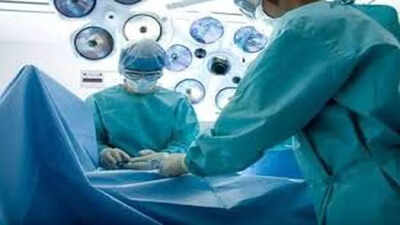Top Searches
- News
- City News
- chennai News
- Chennai hospital saves 93-year-old man from imminent brain stroke by a procedure
Chennai hospital saves 93-year-old man from imminent brain stroke by a procedure

CHENNAI: Multiple severe blocks in the vessels supplying blood to the brain and carotid artery were like a ticking time bomb in the case of this 93-year-old man. But doctors in Apollo Hospitals decided that keeping him awake while removing the blocks was the only way to prevent complications such as stroke and death.
Waking the patient after general anaesthesia would have been a challenge, doctors felt. Hence they used local anaesthesia for a minimally invasive procedure to clear the blocks.
The procedure, carotid endarterectomy, isn’t a new procedure, said senior vascular surgeon Dr V Balaji. “Our department has performed more than 700 such procedures in the last twenty years under regional anaesthesia which reduces postoperative complications to a minimum,” he said. But on Wednesday, he decided to announce the success of this surgery to show that age is no barrier in such surgeries.
The patient, who had complaints of hypertension and bronchial asthma, was having frequent episodes of falls and giddiness.
“There is a pair of carotid arteries on both sides of the neck, and the patient had 99% block in the right carotid arteries. There were blocks in all the four blood vessels supplying blood to the brain,” he said.
During carotid endarterectomy, doctors gave the patient regional anaesthesia and made minimal cuts to remove blocks. This procedure may not be used in patients who land in the hospital with a stroke, Dr Balaji said.
“Less than 2% of patients, like this nonagenarian come in during the transient ischemic attack, which is a minimal warning sign of a massive stroke. For them this procedure is helpful,” he said.
Early signs include numbness or muscle weakness, usually on one side of the body, difficulty speaking or understanding speech, dizziness or loss of balance, double vision or difficulty seeing in one or both eyes and choking.
Apollo Hospitals MD Suneetha Reddy said with AI technology, stroke diagnosis has been standardized and scans would be available remotely within no time to the stroke physician.
“Acting fast when we see a stroke patient is the only awareness that is required,” she said.
Waking the patient after general anaesthesia would have been a challenge, doctors felt. Hence they used local anaesthesia for a minimally invasive procedure to clear the blocks.
The procedure, carotid endarterectomy, isn’t a new procedure, said senior vascular surgeon Dr V Balaji. “Our department has performed more than 700 such procedures in the last twenty years under regional anaesthesia which reduces postoperative complications to a minimum,” he said. But on Wednesday, he decided to announce the success of this surgery to show that age is no barrier in such surgeries.
The patient, who had complaints of hypertension and bronchial asthma, was having frequent episodes of falls and giddiness.
“There is a pair of carotid arteries on both sides of the neck, and the patient had 99% block in the right carotid arteries. There were blocks in all the four blood vessels supplying blood to the brain,” he said.
During carotid endarterectomy, doctors gave the patient regional anaesthesia and made minimal cuts to remove blocks. This procedure may not be used in patients who land in the hospital with a stroke, Dr Balaji said.
“Less than 2% of patients, like this nonagenarian come in during the transient ischemic attack, which is a minimal warning sign of a massive stroke. For them this procedure is helpful,” he said.
Early signs include numbness or muscle weakness, usually on one side of the body, difficulty speaking or understanding speech, dizziness or loss of balance, double vision or difficulty seeing in one or both eyes and choking.
Apollo Hospitals MD Suneetha Reddy said with AI technology, stroke diagnosis has been standardized and scans would be available remotely within no time to the stroke physician.
“Acting fast when we see a stroke patient is the only awareness that is required,” she said.
FOLLOW US ON SOCIAL MEDIA
FacebookTwitterInstagramKOO APPYOUTUBE

Start a Conversation
end of article










